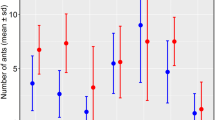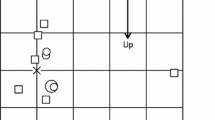Summary
In this 15 month investigation I experimentally demonstrated that sapling Cecropia aff. obtusifolia in lowland western Ecuador grow more vigorously when occupied by the ant Azteca constructor than when the ants have been removed. Thus the interaction is directly beneficial to Cecropia juveniles. The difference in growth is associated with differences in herbivory and vine cover. Removal of ants significantly increases nocturnal Coleoptera herbivory on unoccupied plants. In contrast to the influence on beetle numbers, Azteca are ineffective against Homoptera and cecidomyiid gall flies. Although ant-occupied saplings had less chewing herbivore damage throughout the study, the ants were more effective protectors in the dry season than in the rainy season, when herbivore pressure increased. In addition to reducing herbivory, Azteca efficiently remove vines from occupied saplings.
Similar content being viewed by others
References
Andrade JC de, Carauta JPP (1982) The Cecropia-Azteca association: a case of mutualism? Biotropica 14:15
Bailey IW (1922) Notes on neotropical ant-plants. I. Cecropia angulata sp. nov. Bot Gaz 74:369–391
Baird JN (1967) Observations on the Azteca-Cecropia interaction (Hymenoptera: Formicidae-Moraceae).M.A. Thesis, University of Kansas, Lawrence
Barnwell FH (1967) Daily patterns in the activity of the arboreal ant Azteca alfari. Ecology 48:991–993
Belt T (1874) The naturalist in Nicaragua. J.M. Dent and Sons, Ltd., London
Bentley BL (1977) Extrafloral nectaries and protection by pugnacious bodyguards. Annu Rev Ecol Syst 8:407–427
Bentley S, Whittaker JB (1979) Effects of grazing by a chrysomelid beetle, Gastrophysa viridula, on competition between Rumex obtusifolia and Rumex crispus. J Ecol 67:79–90
Boucher DH, James J, Keeler KH (1982) The ecology of mutualism. Annu Rev Ecol Syst 13:315–347
Brokaw NVL (1980) Gap-phase regeneration in a neotropical forest. Dissertation, U Chicago, Chicago, Illinois, USA
Buckley RC (1982) Ant-plant interactions: a world review. In: Buckley RC (ed) Ant-plant interactions in Australia. Dr. W. Junk Publishers, The Hague, pp 111–162
Coley PD (1983) Intraspecific variation in herbivory on two tropical tree species. Ecology 64:426–433
Dodson CH, Gentry AH (1978) Flora of the Rio Palenque Science Center. Selbyana 4:1–628
Everitt BS (1977) The analysis of contingency tables. Monogr Appl Prob Stat, John Wiley & Sons, New York
Harper JL (1977) Population biology of plants, Academic Press, London
Holdridge LR, Grenke WC, Hatheway WH, Liang T, Tosi JS Jr (1971) Forest environments in tropical life zones: a pilot study. Pergamon Press, New York
Inouye DW, Taylor DR Jr (1979) A temperate region plant-ant-see predator system: consequences of extrafloral nectar secretion by Helianthella guinguenervis. Ecology 60:1–7
Janzen DH (1967) Interaction of the Bull's-horn acacia (Acacia cornigera L.) with an ant inhibitant (Pseudomyrmex ferruginea F. Smith) in eastern Mexico. U Kansas Sci Bull 47: 315–558
Janzen DH (1969) Allelopathy by myrmecophytes: the ant Azteca as an allelopathic agent of Cecropia. Ecology 50:147–153
Janzen DH (1972) Protection of Barteria (Passifloraceae) by Pachysima ants (Pseudomyrmecinae) in a Nigerian rain forest. Ecology 53:885–892
Janzen DH (1973a) Dissolution of mutualism between Cecropia and its Azteca ants. Biotropica 5:15–28
Janzen DH (1973b) Sweep samples of tropical foliage insects: effects of season, vegetation types, elevation, time of day, and insularity. Ecology 54:687–701
Koptur S (1984) Experimental evidence for defense of Inga (Mimosoideae) saplings by ants. Ecology 65:1787–1793
Letourneau DK (1983) Passive aggression: an alternative hypothesis for the Piper — Pheidole association. Oecologia (Berlin) 60:122–126
Marquis RJ (1984) Leaf herbivores decrease fitness of a tropical plant. Science 226:537–539
McKey D (1984) Interaction of the ant-plant Leonardoxa africana (Caesalpiniaceae) with its obligate inhabitants in a rainforest in Cameroon. Biotropica 16:81–99
Müller F (1874) The habits of various insects. Nature 10:102–103
Müller F (1876) On Brazilian kitchen-middens, habits of ants, etc. Nature 13:304–305
O'Dowd DJ (1979) Foliar nectar production and ant activity on a neotropical tree, Ochroma pyramidale. Oecologia (Berlin) 43:233–248
O'Dowd DJ, Catchpole EA (1983) Ants and extrafloral nectaries: no evidence for plant protection in Helichrysum spp.-ant interactions. Oecologia (Berlin) 59:191–200
Putz FE (1984) How trees avoid and shed lianas. Biotropica 16:19–23
Rickson FR (1976) Anatomical development of the leaf trichilium and Mullerian bodies of Cecropia peltata L. Amer J Bot 63:1266–1271
Rickson FR (1977) Progressive loss of ant-related traits of Cecropia peltata on selected Caribbean islands. Amer J Bot 64:585–592
Schemske DW (1980) The evolutionary significance of extrafloral nectar production by Costus woodsonii (Zingiberaceae): an experimental analysis of ant protection. J Ecol 68:959–967
Schupp EW (1981) Interactions between ants and plants: Azteca protection of Cecropia. M.A. Thesis, University of South Florida, Tampa
Stearns S (1976) Life-history tactics: a review of the ideas. Quart Rev Biol 51:3–47
Tilman D (1978) Cherries, ants and tent caterpillars: timing of nectar production in relation to susceptibility of caterpillars to ant predation. Ecology 59:686–692
Waloff N, Richards OW (1977) The effect of insect fauna on growth, mortality, and natality of broom, Sarothamnus scoparius. J Appl Ecol 14:787–798
Wheeler WM (1910) Ants. Their structure, development and behavior. Columbia University Press, New York
Wheeler WM (1942) Studies of neotropical ant-plants and their ants. Bull Mus Comp Zool 90:1–263
Whittaker JB (1982) The effect of grazing by a chrysomelid beetle, Gastrophysa viridula, on growth and survival of Rumex crispus on a shingle bank. J Ecol 70:291–296
Windsor DM (1978) The feeding activities of tropical insect herbivores on some deciduous forest legumes. In: Montgomery GG (ed) The ecology of arboreal folivores. Smithsonian Institution Press, Washington DC, pp 101–113
Wolda H (1978) Seasonal fluctuations in rainfall, food and abundance of tropical insects. J Anim Ecol 47:369–381
Wolda H (1979) Abundance and diversity of Homoptera in the canopy of a tropical forest. Ecol Entomol 4:181–190
Wolda H (1980) Seasonality of tropical insects. I. Leafhoppers (Homoptera) in Las Cumbres, Panama. J Anim Ecol 49:277–290
Author information
Authors and Affiliations
Rights and permissions
About this article
Cite this article
Schupp, E.W. Azteca protection of Cecropia: ant occupation benefits juvenile trees. Oecologia 70, 379–385 (1986). https://doi.org/10.1007/BF00379500
Received:
Issue Date:
DOI: https://doi.org/10.1007/BF00379500




